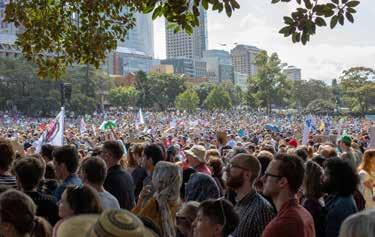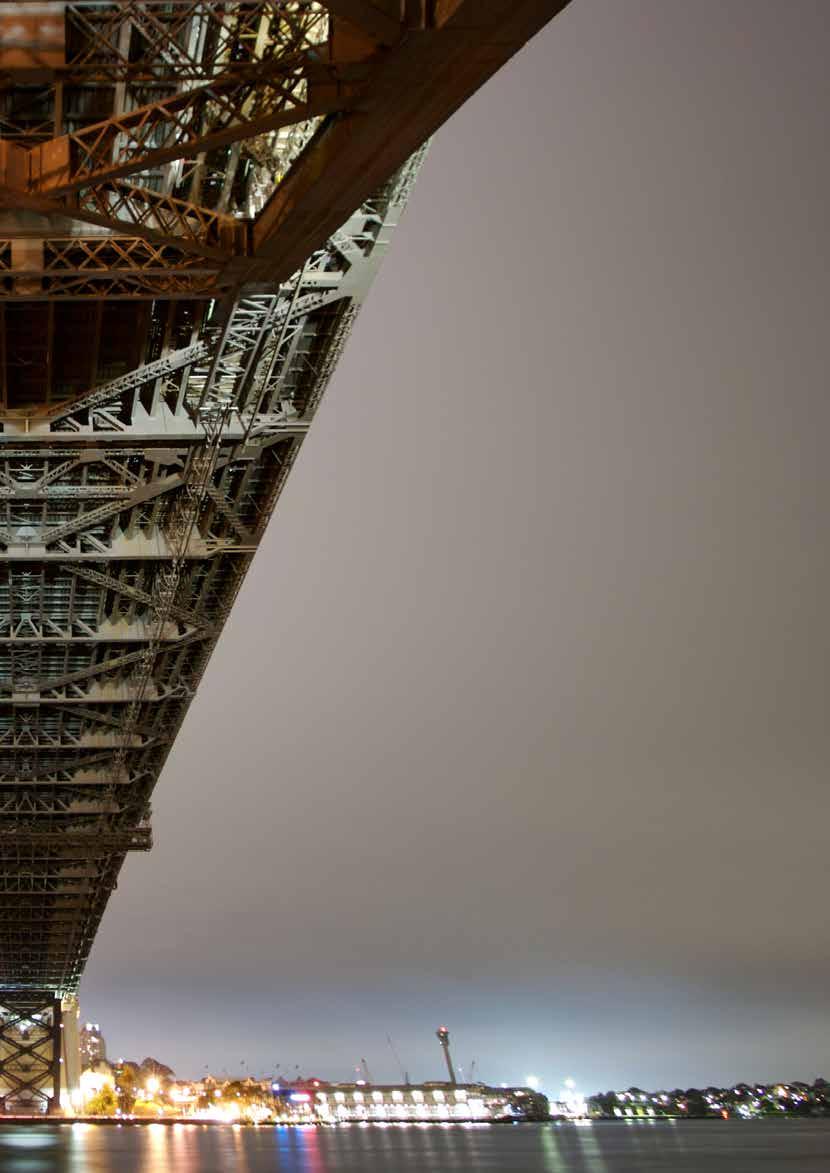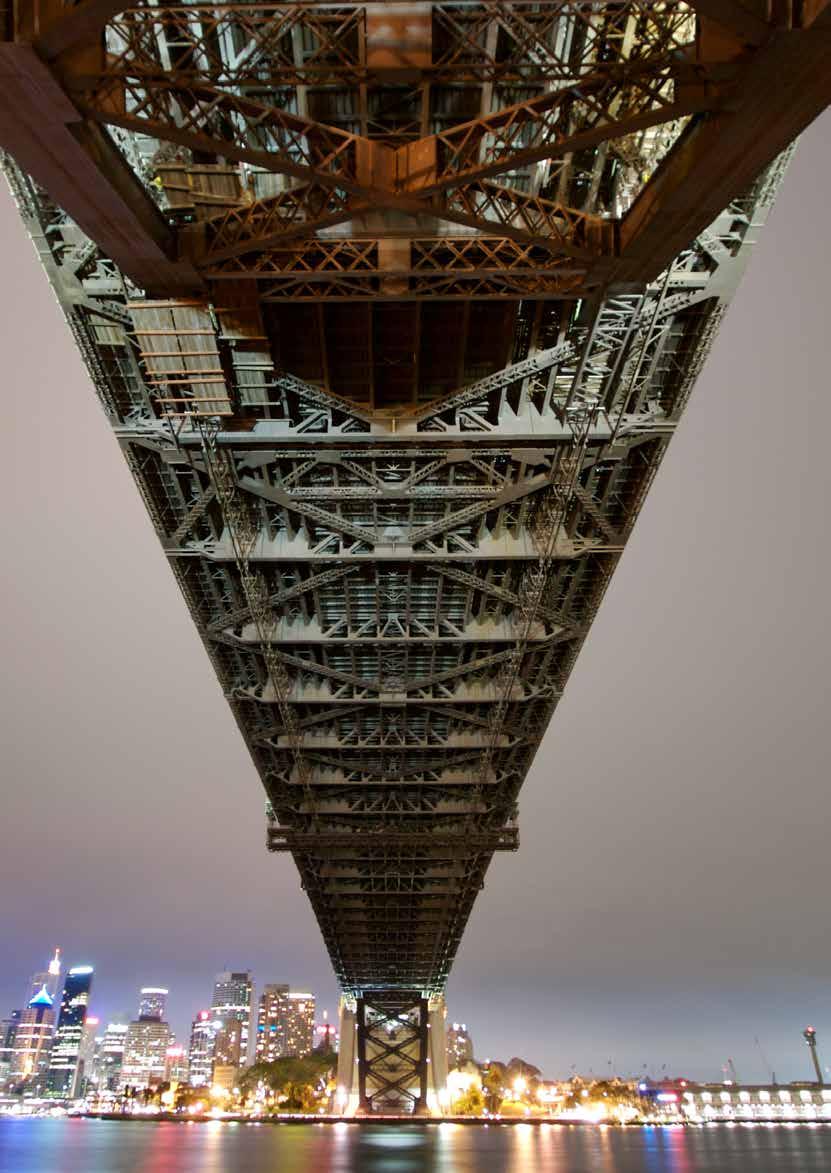
9 minute read
An environment of solidarity
from IE #2 2020
by IEU NSW/ACT
As Australia emerges from the proverbial frying pan of COVID-19, we are leaping straight back into the fire of anthropogenic climate change
and environmental degradation. IE
Advertisement
journalist Angus Hoy writes of the challenges and opportunities facing the union movement as we tackle this global threat.
Growth of the movement
The global environmentalism movement is at a crossroads. By any measure, the state of the Earth has never been more dire. While the volume of conversation around environmentalism and sustainability has never been louder, and environmental organisations are larger and more sophisticated than ever before, the state of the environment continues to degrade.
Modelling has shown that the 2020 Coronavirus response is set to cause the largest ever annual fall in CO 2 emissions – a reduction of a whopping… 5.5%. This meagre reduction is still greater than during any previous economic crisis or period of war.
While the COVID-19 pandemic response has led to massively reduced emissions by the transport sector, research has shown the same cannot be said for the electricity sector in Australia.
In releasing The Australia Institute’s

National Energy Emissions Audit, the report’s author Dr Hugh Saddler said, “Given the disruptive nature of the pandemic and its effect on sectors like transport, it might surprise some that the carbon emissions from electricity – the polluting sector in Australia – have been so small.”
Despite this, there are reports that coal generators and retailers are using the health crisis to lobby to slow down reforms to the National Electricity Market that would allow renewable energy to compete against them.
The reality is that, according to the United Nations Environment Program and IPCC modelling, emissions need to be cut by 7.6% every year to keep global warming from surpassing 1.5 degrees celsius above pre-industrial levels – the threshold at which the most dangerous climate threats become realised.
“The main issue is that people focus way too much on people’s personal footprints, and whether they fly or not, without really dealing with the structural things that really cause carbon dioxide levels to go up,” said Gavin Schmidt, a climatologist and director of the NASA Goddard Institute for Space Studies.
In other words, as summed up in a viral Facebook post, “the people of earth accidentally did a global experiment to see if every individual could course correct climate change through a mass personal change of habits, and it
turns out, no! We can’t! It was massive corporate activity all along!”
The myth of individual personal responsibility for climatic outcomes appears to have been thoroughly debunked. To conclude that there is no place for individuals to engage in grassroots action, however, is a dangerous misinterpretation and abdication of responsibility. Isolated individuals acting alone cannot achieve the necessary change, but individuals coming together to create a collective movement and voice are in with a fighting chance. Unionists have long known the power of organising like this.
Green bans: Jack Mundey and Joe Owens
On 10 May 2020, the Australian union movement mourned the passing of an icon, Jack Mundey, who died at the age of 90 in Sydney. Mundey was an environmentalist, a social justice activist and a staunch union leader, widely celebrated for his internationally pioneering role in the ‘green bans’ movement of the early 1970s.
Mundey, Secretary of the NSW Builders Labourers Federation (BLF) from 1968 to 1973, was followed as Secretary by an equally strong campaigner, Joe Owens, from 1973 to 1975. During the period of the Mundey and Owens leadership, the union forged alliances with local residents across Sydney and NSW to impose
over 42 union bans on potential construction sites in a bid to save sites of environmental, social, and cultural significance.
Mundey and Owens advocated for unions’ obligation to act with a socially responsible purpose extending beyond wages and conditions to include: social and environmental justice, the struggles for women’s liberation, Indigenous civil rights, LGBT equality, and to advocate for the interests of working class people.

Unions and communities save iconic sites
The pioneering work of the NSW BLF, in collaboration with local community activists, helped Sydney retain much of its inner city heritage buildings and locations: scores of heritage buildings; Kelly’s Bush Park in Hunters Hill; green spaces; housing for the Aboriginal community of Redfern; iconic sites of The Rocks, Centennial Park, the Botanic Gardens, Woolloomooloo and other heritage areas across NSW. These actions in turn inspired similar ‘green bans’ across Australia.
In 1971 a group of women from Hunters Hill were trying to save Kelly’s Bush, the last remaining open space in that area, after the developer AV Jennings announced plans to build luxury houses over the bushland. Failing to find help from local council, the local state member or the Premier,



the women approached the NSW BLF as social and economic factors have for support. It is here that the 'green caused many unions to retreat from bans' first gained traction. the position. Activism to protect public
The BLF asked the women to spaces from rampant developers demonstrate broad community continues, both with and without the resistance to the destruction of Kelly’s explicit support of unions, some of Bush. They called a public community today’s activists having learnt the trade meeting attended by over 600 through participation or witnessing of residents, who formally requested the ‘green bans’ of the 1970s. the ban. This provided the BLF with a The additional modern threat mandate for the ban which, in rejecting of anthropogenic climate change the employment opportunity presented heightens the stakes of environmental by the construction, technically went activism beyond those faced in the against the immediate economic 1970s, while battles against rampant interests of its members for the sake development remain as relevant today of a wider community and as they were back then. environmental interest. In a recent history of The Greens in
After the developer declared it would Australia, Mundey criticised elements continue the development using nonof the union movement for their union labour, the BLF not only banned failure to move with the times: “The work from that site but also walked union movement now could be a real, off the job on other AV Jennings sites important instrument in the whole across the city. ecological struggle, because the whole
Government became so alarmed by question of global warming, the whole the effectiveness of these acts of multi-site questions of the environment, is on the solidarity that in 1977, under the Federal agenda for evermore.” Liberal Fraser Government, secondary The Construction, Forestry, Maritime, boycott laws were introduced in an Mining and Energy Union (CFMMEU) attempt to stop it from happening again. is the successor to the BLF. CFMMEU National President Tony Maher has Union movement today laid out the union’s perspective on the
The union movement today is not issue of the environment: “We’re not as vigorously environmentalist as it environmental activists, that’s someone was in the 1970s. Government and else’s job,” said Maher. “We’ll never come legal reforms, a fracturing of the out and oppose a mine that creates jobs.” workplace power of unions due to This perspective, in stark contrast reduced membership density, as well to that of Mundey and the 'green independent education | issue 2 | Vol 50 | 2020 | 25
bans' activists, is nevertheless understandable. Many see a union’s primary mandate as the immediate wellbeing of their members and communities. However, increasing emissions from new coal projects will make the planet uninhabitable for communities around the world, including those of regional coalminers and their children.
Some unions still use their organising might to advocate for climate justice and an inhabitable future. The May 1 Movement, spearheaded by the Maritime Union of Australia Sydney branch, has adopted in its banner of claims: “Climate Action”, alongside “Workers’ Rights” and “Social Justice”. Unions around the country are adopting similar linguistic positions, notably in broad union endorsements of the global student-led “School Strikes 4 Climate”.
A mandate for union-led environmentalism
While Australia is still expanding coal exports and building new mines such as the Adani Carmichael project, Germany, Europe’s biggest economy, is phasing out its entire coal industry for good. Thanks to strong union participation, this process is being achieved without a single worker being sacked. Miners are offered new jobs or an early retirement, and government is delivering tens of billions of dollars to coal regions to create new jobs and industries in the transition.
Australia in 2020 unfortunately does not share the luxury of time enjoyed by Germany, who decided in 2007 to begin the transition away from coal. Any meaningful attempt to reduce Australia’s carbon footprint to the necessary levels would now be far more abrupt and severe.
Despite this, it remains incumbent on unions to keep operating as the world’s largest social justice movement, fighting for the interests and security of workers around the world and of generations to come. The effort, of course, cannot rely solely on workers making the difficult decision to withdraw their labour, if there is no viable proposed alternative ready to assume the space.
A voice for workers
Most 1970s local councillors and decision makers were likely motivated less by greed and self-interest as much as a failure of imagination; fatalistically convinced of the inevitability of unfettered development in pursuit of short term economic advantage. The true value of the 'green bans' was not necessarily the physical reality of construction being halted temporarily


but was instead in the time and space that was created for conversation and opposition from all relevant stakeholders to be heard.
Mundey famously said: “Though we want all our members employed, we will not just become robots directed by developer-builders who value the dollar at the expense of the environment. More and more, we are going to determine which buildings we will build...”
A strongly articulated message of social justice and fair transition is a more constructive position than the CFMMEU’s Queensland mining division’s decision to declare it would not back candidates, regardless of party affiliation, who did not support a future for central Queensland coal jobs in the federal election last year.
Union leaders making these decisions are in an unenviable position; a global transition away from coal will most significantly affect blue-collar workers in regional areas. These workers must be supported and protected on the path to net-zero emissions. Unions and their members are skilled and effective campaigners, and effective grassroots action and solidarity can still drive real policy change. If union leadership is to take the plunge and oppose new mining and extraction developments, they must be confident that policy makers, community leaders and union rank-andfilers will be there with a viable and fully funded plan to not only keep them afloat but help their communities thrive.
To quote Jack Mundey one final time, in a rallying call for all unions across the country: “It is no point winning great wages and conditions if the world we build chokes us to death.”
References:
Saddler, H., 2020. National Energy Emissions Audit Report, The Australia Institute: bit.ly/2Ztm78u IPCC special report: Global Warming of 1.5 ºC, 2020: ipcc.ch/sr15/ Lehne, Bret, Facebook, 2 May 2020: bit.ly/3d37zjG The world is on lockdown. So where are all the carbon emissions coming from? bit.ly/3c19unN Burgmann, M. and Burgmann, V., 1998. Green bans, red union: environmental activism and the New South Wales Builders Labourers’ Federation. UNSW Press. Where do the unions stand on Labor’s climate dilemma? bit.ly/2TzdmWI Germany is shutting down its coal industry for good, so far without sacking a single worker: ab.co/3d0P7bE










